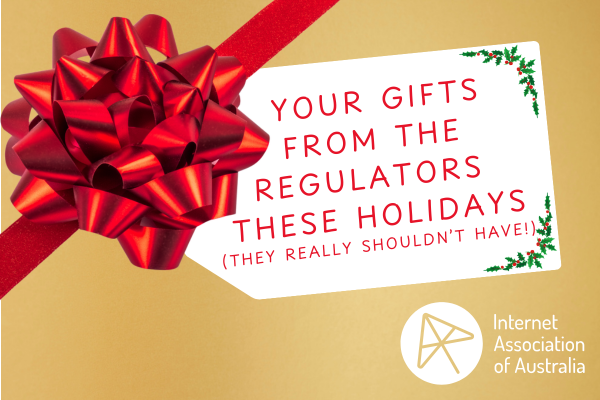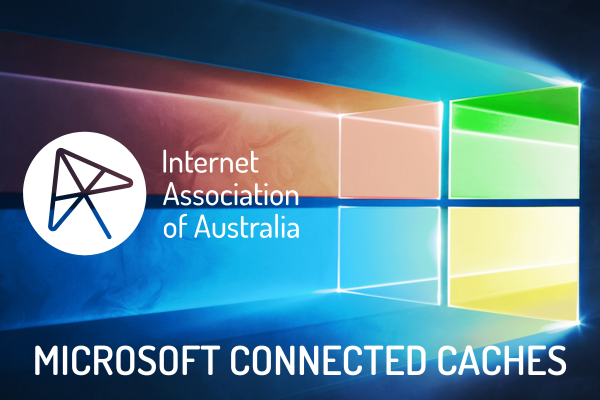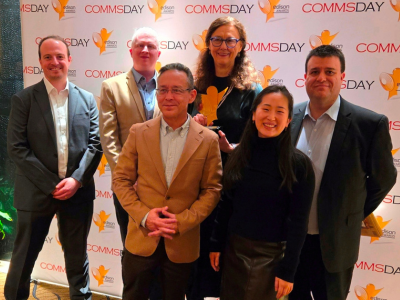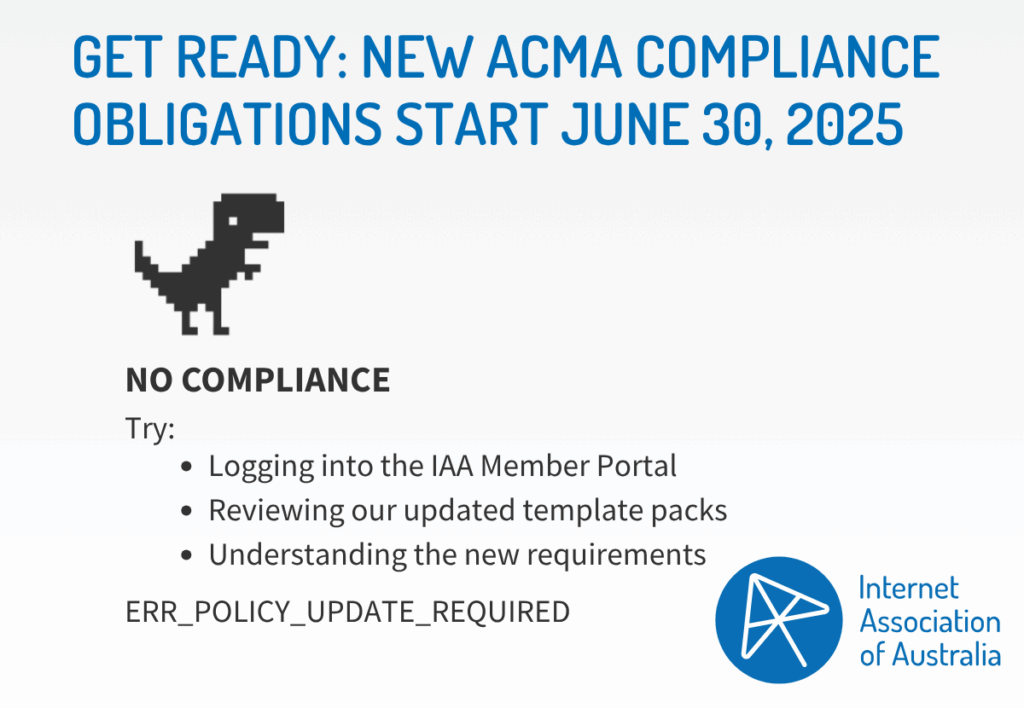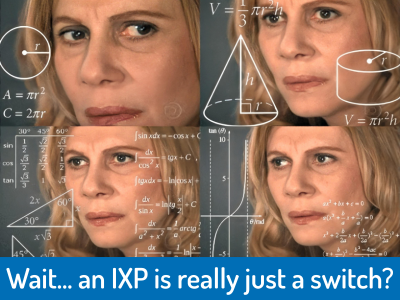Categories
While you may be getting ready to wind down for the end-of-year break, make sure to pay attention to important regulatory reform that will likely affect your business.
Key topics in this update:
- TCP Code – latest progress and what is expected next
- Online Safety obligations – new requirements taking effect 27 December 2025
- Domestic and Family Violence protections – obligations commencing early 2026
Make sure to read on for details on these changes, your compliance obligations, and what IAA is doing to assist our Members.
If you have any questions on any of the below regulatory matters, or want to provide any feedback on the increasing cost of compliance, we’d love to hear from you. Please contact us at policy@internet.asn.au.
TCP Code
The draft Telecommunications Consumer Protections Code (TCP Code) was rejected by the Australian Communications Media Authority (ACMA) in late October, and the Australian Telecommunications Alliance (ATA) was given 30 days to submit a revised TCP Code to address deficiencies identified by the ACMA, failing which, the ACMA would move to direct regulation on consumer protections by way of an industry standard. On 24 November, the ATA submitted a revised TCP Code with significant uplifts, summarised below.
These uplifts have been drafted to ensure the TCP Code is accepted and registered by the ACMA so it remains an industry code, and not a standard subject to direct regulation.
However, IAA is keen to discuss the impacts this would have on your business, particularly the disproportionate effect on small to medium-sized ISPs. Please contact us to share any feedback, which we can relay to the ACMA on a confidential basis.
While the revised TCP Code is currently with the ACMA for consideration, it is very likely that the below uplifts will become mandatory, either through a revised TCP Code or via a new industry standard. We therefore recommend CSPs read and review the changes, and begin assessing what updates may be required within your business to ensure compliance.
Please note, the below summary relate only to the most recent changes contained in the final submission made to the ACMA, and not overall changes to the current TCP Code.
Key proposed uplifts include:
Overall review to improve accessibility and enforceability
- new ‘your rights as a consumer’ section with a consumer-friendly, plain-language overview of the TCP Code;
- stronger, more prescriptive wording to enhance the enforceability of the TCP Code – e.g. changing ‘CSPs should’ to ‘CSPs must’ and removing references to ‘best efforts’ or ‘best endeavours’.
Responsible Selling (Chapter 2 and 5)
- sales incentive structure must also comprise compliance with responsible selling obligations;
- cap on incentives for meeting volume/value targets to be no more than 20% of a staff member’s remuneration;
- negative and proportional consequences for persons who benefitted from mis-selling;
- obligation for staff to disclose to the consumer that they are operating under a sales incentive structure prior to completing an assisted sale;
- new training and assessment obligations;
- ability for consumers to exit contract with no early termination fees where sale was the result of mis-selling.
See also below on the new ‘suitability’ concept.
New ‘suitability’ concept (Chapters 3-5)
- new end-to-end ‘suitability concept’ requiring CSPs to design and offer products that are appropriate for the consumer to address mis-selling practices;
- new training requirement whereby customer-facing staff cannot begin selling until they have been trained and achieve a 100% pass-rate on the suitability of products and services;
- requiring the outcome of a CSP’s suitability assessment to be included in the Critical Information Summary.
- Mobile Coverage (Chapter 5)
- ensuring adequate mobile coverage of a service by offering to check coverage during an assisted sale;
- requiring consumers to acknowledge they have been prompted to check coverage;
- expansion of refunds where mobile coverage does not meet expectations – no termination fees, allowing consumers to pay the remaining device on the same terms and payment schedule if they choose to keep the device purchased alongside the service or return the device in good working order and original packaging for a full refund.
Payment Methods (Chapter 8)
- CSPs must offer direct debit payment flexibility as to:
- the date of payment;
- the frequency of payment (monthly or fortnightly); and
- allow the customer to temporarily defer a payment;
- earlier notification of a failed direct debit payment (2 working days following direct debit attempt);
- new obligation to notify the consumer of the CSP’s payment assistance policy in the event of a failed direct debit attempt;
- new obligation to not issue credit management notices where the CSP identifies a system fault that may have caused the failed direct debit payment, issue a prompt notice of system issue to the customer, and withdrawing any credit management notice that may have been sent;
- new obligation that CSPs must not suspend/disconnect a consumer’s service for credit management reasons where the payment failure is a CSP system fault.
Disconnection (Chapter 9)
- disconnection to only occur as a last resort, and only 20 working days after an overdue bill;
- increased number of notices to be sent prior to a service being disconnected for credit management reasons;
- tiered, three-stage process before disconnection (restriction, suspension, disconnection);
- general obligation for CSPs to ensure their credit management process treats customers with fairness.
Credit Assessments (Chapter 6)
- CSPs must complete a credit assessment where a consumer contract may result in a debt of $300 or more (for residential customers; $2,000 or more for business customers) and not only for debts that would be pursued by the CSP.
You can read more on the TCP Code review on ATA’s website.
Online Safety Code
From 27 December 2025, the Phase 2 Code for ISPs will come into effect, adding to your obligations relating to online safety (Phase 1 Code came into effect in 2023). The Phase 2 Code focuses on protecting children from sexually explicit material online. Make sure you are compliant with the new obligations before you close up shop to make sure you’re not facing enforcement action when you come back next year!
IAA has created guidance material to help Members understand and comply with their obligations. You can access the guidance material on the IAA Member Portal.
You can also read more about the Online Safety Codes on eSafety’s website.
Telco DFSV Standard
Additional obligations under the Telecommunications (Domestic, Family and Sexual Violence Consumer Protections) Industry Standard (DFSV Standard) will come into effect early next year – 1 January for larger providers with at least 30,000 SIOs, and 1 April for smaller providers with under 30,000 SIOs. These include implementing a DFV policy and delivering staff training, with specialised training for customer-facing staff. You can read more on the obligations in our guidance article.
IAA is currently working on developing template material that Members who fall under the <30,000 SIOs can use to comply with the DFSV Standard. We are also looking at organising a webinar that Members can attend and will provide further information on this in due course.
In the meantime, the ACMA have also recently published guidance material on the DFSV Standard, which we strongly encourage you to read.
Thank you for your support throughout 2025
Before you head off for a well-deserved break, thank you for your ongoing engagement with IAA. Enjoy the holidays, and we’ll continue helping you tackle these regulatory changes in 2026.
Following this year’s election, we’re pleased to congratulate our newly elected Directors who will help guide IAA’s direction for 2026 and beyond.
Re-elected for a three-year term:
Matthew Enger – Professional Member, CEO of Leaptel
Now heading into his sixth year on the IAA Board, Matthew continues to champion efficiency, transparency, and the voice of smaller providers in an increasingly complex regulatory environment. With extensive experience leading a growing RSP, he brings both technical and commercial insight to ensure IAA remains responsive to Members’ needs and focused on strengthening Australia’s internet infrastructure.
Nathan Brookfield – Professional Member, Managing Director of Managed Networks
Nathan returns to the Board with nearly two decades of industry experience spanning data centre operations, network design, and ISP management. Having first served on the Board back 2015, he remains committed to strong governance, sustainable growth, and advocacy on behalf of Members across the internet and telecommunications sector.
Elected to fill a one-year casual vacancy:
Karla Stokes – Professional Member
Karla joins the Board with over 20 years of leadership experience across technology, infrastructure, and industry advocacy. A long-time supporter of the IAASysters program, she brings deep expertise in registry operations, member engagement, and digital policy development from her time at APNIC and PPCA. Karla’s inclusive leadership and strategic perspective will be a valuable addition to IAA’s ongoing work supporting diversity and innovation across the industry.

Following on from the success of last year’s IAASysters Board Mentorship, we’re pleased to introduce this year’s mentee, Fiona Atkinson. Fiona is a Network Planner at Sony Interactive Entertainment, bringing experience in peering, capacity planning, and network procurement across fibre, internet exchanges, and co-location services. Under the guidance of IAA Board Chair Matthew Enger, she will spend the next year gaining hands-on experience in board governance, strategic decision-making, and leadership within Australia’s internet industry.
We’d also like to thank last year’s mentee, Emma Mondy, for her outstanding contribution to the program and to the Board during her time filling a casual vacancy. Her commitment and insight helped set a strong foundation for future participants.
We’re expanding our CDN offering! Next Tuesday, 12 August 2025, Microsoft Connected Caches (MCC) are going live on our exchanges in Adelaide, Brisbane, Melbourne, and Perth via AS10084.
This will bring Microsoft content such as OS updates, games, applications, and static assets even closer to your users. MCC delivers content not available via AS8075.
During our testing in a single exchange we saw cache traffic egress over 20-40Gbps, so we expect members to see notable traffic spikes during Microsoft’s weekly release schedule each Wednesday (AU time)
MCC is by default opt-in, so we recommend checking your port sizing to avoid congestion. If you need time out to upgrade, opt-out BGP communities are available – see our CDN policy control communities page for details.
Questions? Reach out to us at peering@internet.asn.au.
We’re proud to share that Narelle Clark, CEO of the Internet Association of Australia, has been officially inducted into the CommsDay Hall of Fame.
Announced at the 2025 CommsDay Summit in Sydney in June, this honour celebrates Narelle’s decades of impact across consumer advocacy, internet infrastructure, and policy. Her work has helped shape a more connected, inclusive, and resilient digital Australia.
As CEO of IAA, Narelle continues to lead with insight, integrity, and purpose championing a stronger, more community-focused internet for all.
Congratulations, Narelle a well-deserved recognition!
Telecommunications providers must act now to ensure compliance with the below major regulatory changes coming into force from as early as 30 June 2025:
- Telecommunications (Consumer Complaints Handling) Industry Standard Amendment 2025 (No. 1) – Commencing 30 June 2025
- Telecommunications (Customer Communications for Outages) Industry Standard Variation 2025 – Commencing 30 June 2025
- Telecommunications (Domestic, Family and Sexual Violence Consumer Protections) Industry Standard 2025 – Commencing 1 July 2025
We have updated template packs provided on the IAA Member Portal to assist Members with their compliance obligations, but it is important Members understand new requirements arising from recent regulatory reform.
1. Expanded Complaints Handling Framework
From 30 June, telco providers will have to comply with new obligations in relation to handling complaints from consumers including:
- New “Network Outage Complaint” Category:
A new “network outage complaint” is now explicitly defined to align with the Telecommunications (Customer Communications for Outages) Industry Standard 2024. If a consumer reports loss of service and the provider suspects a network outage is occurring (either a major outage or significant local outage), the report must be treated as a formal network outage complaint
- Network Outage Complaints Handling Process:
Providers must establish a separate, documented process for handling network outage complaints and publish it on their website. IAA’s Template Complaints Handling Policy has been updated to include network outage complaints, and is available on the IAA Member Portal.
- Resolution Standards for Network Outage Complaints:
A network outage complaint is resolved once:- Service is restored, and
- A bulk resolution offer (e.g. compensation or credit) is communicated (if offered)
- Natural Disaster Exclusion:
Complaints related to outages triggered solely by natural disasters may be handled through standard complaint processes instead. - Improved Accessibility:
The ACMA have also introduced other changes unrelated to network outage complaints in relation to making complaints and complaints handling process more accessible. This includes, amongst other things, maintaining a direct link on the telco’s homepage and the help or support section of its website to display a list or table of each of the contact details the provider makes available to receive complaints, along with a statement that these contact points can be used to make a complaint.
2. Enhanced Communications During Outages
The Telecommunications (Customer Communications for Outages) Industry Standard has also been updated to introduce obligations in relation to ‘significant local outages’, which commence 30 June. Please note, obligations already exist in relation to ‘major outages’.
Variation Highlights:
- New defined term – ‘significant local outages’
‘Significant local outage’ is defined as unplanned adverse impact to your telco network that results in an end-user unable to establish and maintain a carriage service which affects:- ≥1,000 SIOs in regional Australia for a period of over 6 hours;
- ≥250 SIOs in remote Australia for a period of over 3 hours.
- Notification obligations in relation to a significant local outage
Carriers and CSPs must notify and communicate with select persons and groups at different stages including initial notification, regular updates, updates of material changes, and service restoration. IAA provides updated template kits including template notifications and communications that carriers and CSPs can send out in relation to both major outages and significant local outages in the IAA Member Portal. - Written Procedures
Telcos must update their public-facing Network Outage Communications Policy to include their procedures in relation to a significant local outage. A template policy is also included in the Template Kit provided by IAA.
3. New Protections for Persons Affected by Domestic, Family & Sexual Violence
ACMA has introduced a new industry standard to establish protections for persons affected by domestic, family and sexual violence. While the Standard commences from 1 July, telcos will have a longer timeframe to comply with many of the requirements. Below are only the compliance requirements that begin from 1 July:
- Reversal of service limitation for affected persons (s 13(3)-(5)):
If a service has been limited (e.g. suspended or disconnected), and the affected person urgently requests reversal due to a DFV safety risk, the telco must urgently reverse it on first contact, or offer an equivalent service if reversal isn’t practical. However, reversal isn’t required where doing so would breach another Commonwealth law (e.g. emergency call service obligations).
Must not require affected persons to engage with perpetrator (s 15(1)):
Telcos must not require a person affected by DFV to contact or interact with the perpetrator of the DFV or the perpetrator’s authorised representative. - Information about support offered (s 16)
Telcos must publish information on their website about the support they offer to people affected by domestic and family violence. If they don’t yet offer specific support, they must publish contact details for external support organisations and indicate when their own support services will become available. - DFV Policy (s 19-20)
Telcos must develop and implement a domestic and family violence (DFV) policy, that is approved by the telco’s most senior executive, and develop supporting procedures that meet specific standards. Large providers have 6 months, and small providers 9 months from 1 July to comply. - General DFV Training (s 21)
All personnel must receive DFV training, which can be delivered internally or via an expert 3rd party. Large providers have 9 months, and small providers 12 months from 1 July to complete training, with annual refreshers of the training to be completed. - Specialised DFV Training for Customer-Facing Staff (s 22)
Personnel in customer service, or likely to deal with DFV issues must complete specialised DFV training which covers applying the telco’s DFV policy and procedures, nature of DFV and its relationship to telco services, how to identify affected persons, intersectionality and DFV, engaging with affected persons, and recognising and prioritising safety of affected persons and the safety of personnel engaging with perpetrators. The specialised DFV training can be tailored to the role of the personnel, and may be delivered internally or via an expert 3rd party. Large providers have 9 months, and small providers 12 months from 1 July to complete training, with annual refreshers of the training to be completed. - Consultation requirements (s 32)
From 1 July, telcos must consult with and consider feedback from DFV support services and either people with lived experience or organisations representing at-risk groups when developing DFV policies and procedures (s 19), and training (s 21-22). Large providers must consult directly; small providers may do so via an industry body.
A large provider means a provider with at least 30,000 SIOs, and a small prover is a provider with less than 30,000 SIO.
Please note, IAA is considering whether and how to undertake the consultation requirements on behalf of our members that fall under the ‘small provider’ category. If you are interested in being represented by IAA, please let us know by contacting policy@internet.asn.au.
What Telcos Must Do
Compliance Area | Required Actions |
Complaints Handling (30 June) | Update processes and policies to handle and display network outage complaints separately. Update website to specify points of contact to make complaints. Ensure staff are trained to appropriately handle any network outage complaints as such. |
Network Outage Communications (30 June) | Update internal processes to ensure communications are sent in relation to significant local outages. Update public facing policy to include communications processes in relation to significant local outages. |
DFSV Protections (1 July) | Ensuring staff understand all obligations that will commence from 1 July that relate to persons affected by DFV – e.g. not requiring affected persons to contact perpetrators, reversing service limitations. Updating website to specify support information. Undertaking consultation requirements to develop DFV Policy, procedures and training. Training staff. |
If you have any questions about the any of the new regulation, please contact us at policy@internet.asn.au.
Written by: Sophia Joo | Senior Policy Officer & Company Secretary
⚡️Network Engineers & Internet Peering Enthusiasts, let's talk about something fundamental yet often misunderstood!⚡️
When we talk about the power and efficiency of the Internet, we often highlight Internet Exchange Points (IXPs) as critical interconnection hubs. And they absolutely are! However, it’s crucial to remember that a typical Internet Exchange fabric is a pure Layer 2 construct.
What does that mean in practical terms?
An IXP does NOT perform any routing for or on behalf of its peering participants.
Think of it this way:
It’s a giant, shared Ethernet switch. Your router connects to it, and its sole purpose is to forward Ethernet frames between connected participants’ routers based on MAC addresses.
Each participant is responsible for their own routing decisions. The IXP itself only influences which routes you learn from their route servers, or advertise via their route servers, based on things like attached control communities and RPKI ROA validity. This doesn’t include so-called “bi-lateral” BGP sessions with peering partners directly across the exchange, which are entirely free of IXP influence!
No IP forwarding tables, no MPLS labels, no routing protocols running within the IXP’s core fabric for participant traffic. Most IXP’s operational networks will have their own underlay routing, but that’s distinct from the participant traffic plane.
Why is this understanding critical?
– Troubleshooting: If you’re experiencing routing issues with a peer at an IXP, your focus should be on your BGP configuration, your router’s health, and the peer’s BGP configuration – not on the IXP “routing” your traffic incorrectly.
– Architecture: IXP peering is decentralised by nature. You’re effectively building direct relationships with others, not relying on a central router.
– Security: An IXP isn’t inspecting or manipulating your IP packets beyond some basic ingress filtering of “nuisance” traffic, to ensure the health of the exchange. Ultimately, the exchange simply provides physical and data link layer connectivity between networks.
– Performance: The beauty of Layer 2 is its speed and simplicity. It allows direct, low-latency communication between networks, which is exactly what IXPs want to give peers!
Next time you connect to an IXP, remember you’re essentially plugging into a massive switchboard designed for efficient, direct peer-to-peer conversations, not a traffic cop directing everyone’s data.
Written by: Matthew Kobayashi | IAA Peering Engineer
